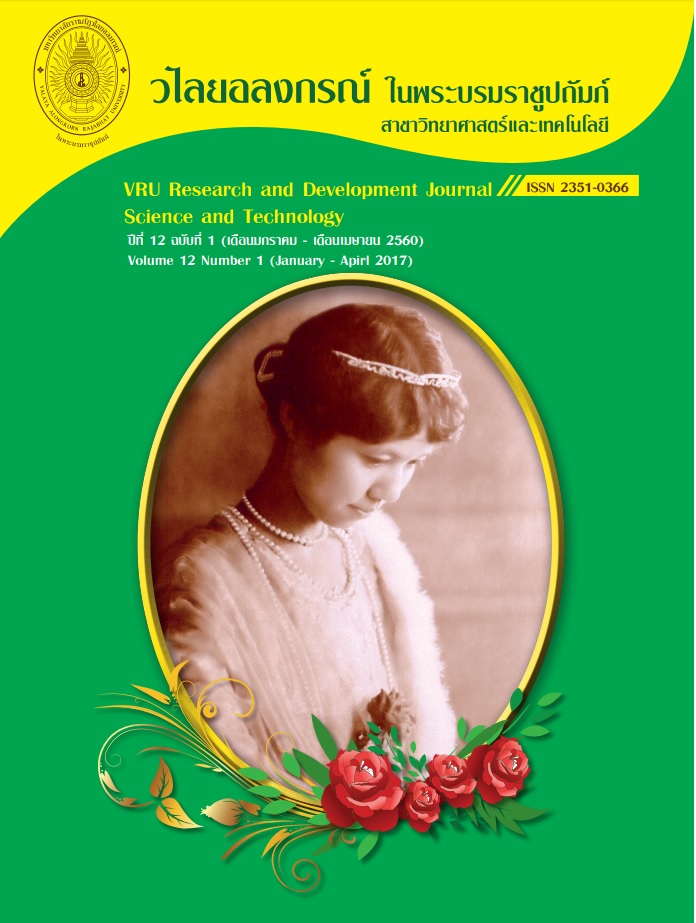การสังเคราะห์และคุณสมบัติของซีโอไลต์สี่เอสำหรับการดูดซับโลหะหนัก
Main Article Content
Abstract
แร่หลักในดินขาวคือเกาลิไนต์ซึ่งมีสูตรทางเคมีเป็น Al2O3.2SiO2.2H2O และโครงสร้างประกอบด้วยซิลิกาเตตระฮีดรอลและอลูมินาออกตะฮีดรอลรวมกันเป็นรูปแบบชั้นหน่วยของดินขาว วัตถุประสงค์ของงานวิจัยนี้เพื่อสังเคราะห์ซีโอไลต์สี่เอจากดินขาวธรรมชาติในประเทศไทยด้วยกระบวนการเมตาเกาลินไนเซชันและซีโอไลต์เซชัน สารตัวอย่างที่ใช้คือดินขาวธรรมชาติจากจังหวัดระนอง ดินขาวแห้งประมาณ 600 กรัม ถูกคัลไซน์ที่อุณหภูมิ 400-700 องศาเซลเซียส เป็นเวลา 3 ชั่วโมง หลังจากนั้นนำ 500 กรัมของเมตาเกาลินไนต์มาทำการกวนด้วยสารละลายโซเดียมไฮดรอกไซน์ความเข้มข้น 0.5-3.5 โมลาร์ ที่อุณหภูมิ 70-90 องศาเซลเซียส วัตถุดิบและผลิตภัณฑ์ถูกตรวจสอบคุณสมบัติด้วยเทคนิคการเลี้ยวเบนของรังสีเอกซ์ (XRD) กล้องจุลทรรศน์อิเลคตรอนแบบส่องกราด (SEM) และเอกซ์เรย์ฟลูออเรสเซนต์ (XRF) ผลของการทดลองพบว่าดินขาวประกอบด้วยเกาลินไนต์เป็นองค์ประกอบหลัก ลักษณะผลึกของซีโอไลต์สี่เอที่สังเคราะห์ได้มีรูปทรงเป็นลูกบาศก์ขนาดประมาณ 2 ไมโครเมตร และองค์ประกอบของดินขาวประกอบด้วยซิลิกาและอะลูมินาเป็นองค์ประกอบหลัก การวิจัยนี้สรุปได้ว่าดินขาวระนองสามารถเตรียมเป็นซีโอไลต์สี่เอได้ โดยการกระตุ้นดินขาวด้วยสารละลายโซเดียมไฮดรอกไซด์ภายใต้สภาวะที่เหมาะสม ที่อุณหภูมิ 90 องศาเซลเซียส เป็นเวลา 3 ชั่วโมง และการตกผลึกที่อุณหภูมิ 600 องศาเซลเซียส เป็นเวลา 3 ชั่วโมง ร้อยละการดูดซับโลหะหนักตะกั่ว แคดเมียม และทองแดง คือ 97.01 96.95 และ 97.12 ตามลำดับ
The principal mineral in clay is kaolinite having a chemical formular Al2O3.2SiO2.2H2O and the structure consists of a single silica tetrahedral sheet and a single alumina octahedral sheet combined to form the clay unit layer. The purpose of this research was to synthesize zeolite-4A from the natural clay in Thailand via a metakaolinization and zeolitezation process. The sample used was natural clays from Ranong province. About 600 g of clay was calcined at 400-700 OC for 3 h. About 500 g of the metakaolinite was dissolved in 0.5-3.5 M NaOH followed by ageing at 70-90 OC. Both of the raw materials and the final product were characterized by X-ray Diffraction (XRD), Scanning Electron Microscope (SEM) and X-ray Fluorescence (XRF). The experimental results were showed that Ranong clay consisted of kaolinite. The zeolite-4A was cubical edge and the crystal size was estimated to be 2 μm; and clay consisted mainly of silica and alumina. It can be concluded that clay used as raw material in this experiment is the kaolinite that as the zeolite-4A which was prepared from clay by activation treatment using sodium hydroxide under the proper condition. The optimum parameters can be prepared zeolite-4A from clay by ageing at 90 OC for 3 h and crystallized at 600 OC for 3 h. For adsorption characteristic of synthesized zeolite-4A, adsorption percentage of lead cadmium and copper were 97.01 96.95 and 97.12 respectively.
Downloads
Article Details
Copyright Notice
The copyright of research articles published in the VRU Research and Development Journal Science and Technology Journal belongs to the Research and Development Institute, Valaya Alongkorn Rajabhat University under the Royal Patronage. Reproduction of the content, in whole or in part, is prohibited without prior written permission from the university.
Responsibility
The content published in the VRU Research and Development Journal Science and Technology Journal is the sole responsibility of the author(s). The journal does not assume responsibility for errors arising from the printing process.
References
D. Akolekar, A. Chaffee and R. F. Howe. (1997). The transformation of kaolin to low-silica X zeolite. Zeolites. 19, 359-365.
D. Georgiev, B. Bogdanov, K. Angelova, I. Markovska and Y. Hristov. (2009). Synthetic Zeolite – Structure, Clasification, Current Trends in Zeolite Synthesis Review. International Science conference 4th-5th June 2009, Stara Zagora, BULGARIA.
D. Novembre, B. Di Sabatino, D. Gimeno, M. Garcia and S. Martinez. (2004). Synthesis of Na-X zeolite from tripolaceous deposits (Crotone, Italy) and volcanic zeolitised rocks (Vico volcano, Italy). Microporous and Mesoporous Materials. 75, 1-11.
Eze k. A., Nwadiogbu J.O., and Nwankwere E.T. (2012). Effect of Acid Treatments on the Physicochemical Properties of Kaolin Clay. Archives of Applied Science Research. 4(2), 792-794.
Gates B.C., (1992). Catalytic Chemistry, Wiley.
Jalil R. Ugal, Karim H. Hassan, and Inam H. Ali. (2010). Preparation of type 4A zeolite from Iraqi kaolin: Characterization and properties measurements. Journal of the Association of Arab Universities for Basic and Applied Science. 9, 2-5.
Nadia R. C. F. M. และ Denise M. M. M. (2005). Synthesis of Na-A and –X zeolite from oil shale ash. Fuel. 84, 2289-2294.
S. Chandrasekhar, P. Raghavan, G. Sebastian and A. D. Damodaran. (1997). Brightness improvement studies on kaolin based zeolite 4A. Applied Clay Science. 12, 221-231.
Szostak, R., (1989). Molecular Sieves: Principles of Synthesis and Identification. Van Nostrand Reinhold, New York.


